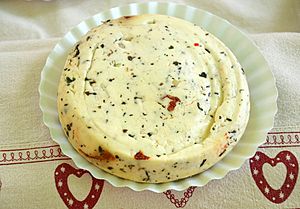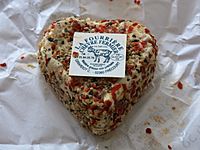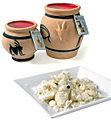Goat's milk cheese facts for kids
Goat's milk cheese is a type of cheese made using milk from a goat. It's different from cheese made from cow's milk. Goat cheese often has a unique color, texture, and flavor. It is usually white and can be quite crumbly. Because it breaks apart easily, it is sometimes stored in plastic containers with water.
Goat's milk cheese is very popular in places where it's harder to raise cows. This includes many Mediterranean countries and parts of the Middle East. Goats are often easier to keep in dry or mountainous areas.
Contents
Why Goat Cheese is Unique
Goat's milk has a different makeup than cow's milk. This gives goat cheese its special qualities.
- Flavor: Goat cheese often has a tangy, earthy, or "goaty" taste. This flavor can be mild or strong. It depends on the goat's diet and how the cheese is made.
- Texture: Young goat cheese is usually soft and creamy. It can be spread like butter. As it gets older, it becomes firmer and more crumbly. Some aged goat cheeses are hard and can be grated.
- Color: Most goat cheeses are bright white. This is because goats process beta-carotene differently than cows. Beta-carotene is a yellow pigment found in plants. Cows store it in their fat, making their cheese yellowish. Goats convert it to vitamin A, so their milk and cheese stay white.
How Goat Cheese is Made
Making goat cheese is similar to making other types of cheese.
Collecting the Milk
First, fresh goat's milk is collected. The milk is often pasteurized. This means it is heated to kill any harmful bacteria.
Curdling the Milk
Next, a starter culture is added to the milk. This culture contains good bacteria. It helps the milk to become acidic. Then, a substance called rennet is added. Rennet makes the milk curdle, or separate. It forms solid curds and liquid whey.
Draining and Shaping
The curds are then separated from the whey. This is often done by draining them in cheesecloth or molds. The curds are pressed to remove more liquid. This process shapes the cheese.
Salting and Aging
Finally, the cheese is salted. Salt adds flavor and helps preserve the cheese. Some goat cheeses are eaten fresh. Others are aged for weeks, months, or even years. Aging changes the cheese's flavor and texture.
Popular Types of Goat Cheese
There are many kinds of goat cheese around the world. Each has its own special characteristics.
- Chevre: This is a French word for goat. "Chevre" often refers to fresh, soft goat cheese. It's usually white and has a tangy flavor. It can be rolled in herbs, ash, or spices.
- Feta: While often made from sheep's milk, some Feta cheese is made from goat's milk. It is a brined, crumbly cheese. It has a salty, tangy taste.
- Halloumi: This cheese is popular in the Middle East. It is often a mix of goat's, sheep's, and cow's milk. It has a high melting point. This makes it great for grilling or frying.
- Garrotxa: This is a semi-hard goat cheese from Catalonia, Spain. It has a natural rind and a mild, earthy flavor. It is aged for a few months.
Goat Cheese Around the World
Goat cheese is a staple in many cultures.
- Mediterranean Countries: In places like Greece, France, Italy, and Spain, goat cheese is very common. It's used in salads, pastries, and main dishes.
- Middle East and North Africa: Goats are well-suited to the climates here. Goat cheese is a traditional food. It is often served with bread and olives.
- United States: Goat cheese has become very popular in the U.S. in recent years. Many small farms now produce artisan goat cheeses.
Goat's milk cheese is a versatile and tasty food. It offers a unique flavor that many people enjoy.
Images for kids
-
A selection of fresh and cured ġbejniet
-
Goat cheese from Yeghegnadzor, Armenia
See also
 In Spanish: Queso de cabra para niños
In Spanish: Queso de cabra para niños








